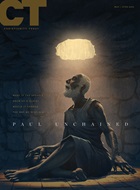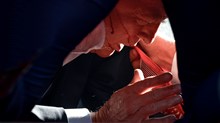Galileo was tortured by the Inquisition because his discoveries did not jibe with church teachings. Charles Darwin hesitated to publish his work because he feared a backlash from clergy. Missionaries systematically destroyed native cultures around the globe. Millions of witches were burned in the Middle Ages because the church didn't want women to have any power.
All of the above statements have three things in common. One, they are frequently repeated in popular and even scholarly writing. Two, they portray Christians in exceedingly unfavorable light. Three, they are all false.
In the new book 6 Modern Myths About Christianity & Western Civilization (InterVarsity), Philip J. Sampson deconstructs such "modern stories of our place in the universe [which] cannot be regarded as history simply because they are recent texts." In addition to the four myths mentioned above, he tackles the notions that Genesis is an environmentalist's nightmare and that Christians loathe the human body.
Sampson traces each myth to its origins, often in the nineteenth century, then gives it the drubbing it deserves. Frequently even a cursory look at the historical facts uncovers fraud. For example, Sampson notes, Galileo was never tortured; he had servants during his imprisonment and died peacefully in his bed. Darwin was far more concerned about ridicule from his scientific colleagues than about opposition from Christians. Missionaries were usually the most vocal opponents of colonial injustices such as slavery, the liquor trade, and the abuse of native women. By the best recent estimates, fewer than 100,000 witches were executed in Europe and North America over 300 years of "witch-hunting," and the numbers were comparatively low in the countries (Italy and Spain) where the Inquisition was strongest.
Glaring factual errors are not, however, Sampson's real prey. He is most interested in exposing the ways in which modern myths, like ancient ones, are used to bolster the authority of ruling powers and discredit potential challengers. Enlightened science proclaims its supremacy over superstitious religion by proving that, when the two clashed in the past, the church always showed itself to be stupid, stubborn, and downright malicious. Pluralism gets a boost by portraying Christianity as the mortal enemy of cultural diversity. Environmentalists, feminists, Wiccans—anyone can shore up claims to legitimacy or even coveted victim status by taking pot shots at the church.
Not only do assaults on the church make Christians look bad and the attackers look good, Sampson argues, such assaults relieve secular powers of responsibility for society's ills. This agenda is particularly evident in the modern witch-hunting myth. Sampson writes, "The fact is that somewhere between 90 and 99 percent of the cruel deaths reported by the story of witch-hunting are fictional. Exaggeration on this scale requires explanation. What can have possessed so wide a range of authors to imagine the torture and execution of millions of women? No doubt there are many social and psychological factors involved here, but by inventing so many deaths and attributing them to the church, the modern mind evades its own responsibilities and gains an alibi for the unprecedented slaughter of the twentieth century."
Sampson does a good job of making serious material highly readable. He has done his research (each chapter has dozens of endnotes), but he doesn't hit readers over the head with it. He also remains quite balanced, considering that his topic is a myth-busting defense of Christianity. Where critics are right and Christians were wrong, Sampson is not afraid to admit it.
Sampson's approach will not, however, appeal to everyone. He overwhelmingly relies on secondary sources, which is appropriate where his point is how badly other writers have mangled the truth but discomfitting where he is attempting to set the record straight. The use of endnotes, rather than footnotes or in-text citation, compounds this problem, because the reader cannot immediately tell how authoritative Sampson's sources really are. Also, Sampson's cases against the myths are uneven—some appeal primarily to Scripture, some to historical facts, some to differences of interpretation. One wonders (a) whether the "winner" would be so clear if different aspects of each case were highlighted, and (b) which form of argumentation is closest to Sampson's expertise. The book's dustjacket declines to identify the author's specialty, noting merely that he holds a Ph.D. in "social sciences."
6 Modern Myths will raise some eyebrows (mine shot up at several points) and give laypeople valuable resources for defending Christianity against its cultural despisers. Unfortunately, due to its popular focus, the book will probably do little to curtail the myths' circulation. Erasing each of these misconceptions from societal memory will probably require an all-out scholarly crusade. Perhaps Sampson will inspire some brave souls to take up the task.
* An article on Christians' response to Darwinism appears in CH issue 55: Fundamentalism. Questions about missionary motives and accomplishments are raised in issue 56: David Livingston.
Elesha can be reached at cheditor@ChristianityToday.com.
The online issue archive for Christian History goes as far back as Issue 51 (Heresy in the Early Church). Prior issues are available for purchase in the Christian History Store.
Copyright © 2001 by the author or Christianity Today/Christian History magazine.
Click here for reprint information on Christian History.

Support Our Work
Subscribe to CT for less than $4.25/month




























